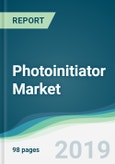The photoinitiator market is estimated to be valued at US$2.142 billion in 2018 and is projected to grow at a significant rate during the forecast period. Photoinitiators are small molecules that transform light energy into chemical energy to induce chemical reactions. There has been a rise in demand for photoinitiators due to their excellent properties such as relative stability and range of light absorption. Rising demand for UV-cured coating photoinitiators in the electronic assembly is boosting the growth of the photoinitiators market. Advancements in light-cure adhesive technology will further continue to drive the growth of photoinitiators market during the next five years. Geographically, APAC holds a significant market share owing to the rising end-user industries including electronics, packaging, and automotive.
Drivers
Restraints
Industry Update
The major players profiled in the photoinitiator market include IGM Resins, Hubei Gurun Technology Co., Ltd., Tronly, Photo High Technologies, Lambson, and Merck KGaA.
Segmentation
The Photoinitiator Market has been analyzed through the following segments:
By Type
By Application
By Geography
North America
South America
Europe
Middle East and Africa
Asia Pacific
Drivers
- Strict regulations regarding VOC emissions
- Rising demand for UV-cured coating
Restraints
- Fluctuations in raw material prices
Industry Update
- Recently in August 2019, IGM has announced the global expansion of its photoinitiator manufacturing by setting up a new Greenfield site in China while upgrading the Mortara, Italy’s manufacturing facility.
- European private equity group Astorg acquired IGM Resins from Arsenal Capital Partners in 2018.
The major players profiled in the photoinitiator market include IGM Resins, Hubei Gurun Technology Co., Ltd., Tronly, Photo High Technologies, Lambson, and Merck KGaA.
Segmentation
The Photoinitiator Market has been analyzed through the following segments:
By Type
- Free-radical
- Cationic
By Application
- Inks
- Adhesives
- Coatings
By Geography
North America
- USA
- Canada
- Mexico
South America
- Brazil
- Argentina
- Others
Europe
- United Kingdom
- Germany
- France
- Italy
- Others
Middle East and Africa
- Saudi Arabia
- UAE
- Israel
- Others
Asia Pacific
- China
- Japan
- India
- Australia
- Others
Table of Contents
1. INTRODUCTION
2. RESEARCH METHODOLOGY
4. MARKET DYNAMICS
5. PHOTOINITIATOR MARKET BY TYPE
6. PHOTOINITIATOR MARKET BY APPLICATION
7. PHOTOINITIATOR MARKET BY GEOGRAPHY
8. COMPETITIVE INTELLIGENCE
9. COMPANY PROFILES
Companies Mentioned
- IGM Resins
- Hubei Gurun Technology Co., Ltd.
- Tronly
- Photo High Technologies
- Lambson
- Merck KGaA.
Methodology

LOADING...








